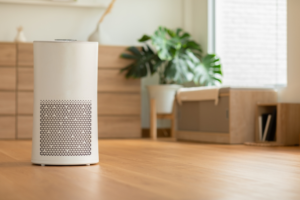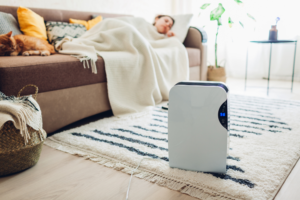If you’re someone who is susceptible to changes in the season or you want a cleaner environment in your home, choosing to purchase an air treatment appliance could be a great choice for you. Air purifiers and dehumidifiers are two types of appliances that help your homes air quality remain clean and crisp, but what’s the difference? Read on to find out more about the two appliances with this Canstar Blue guide.
What is an air purifier?

An air purifier circulates air through HEPA (High Efficiency Particulate Air) filters, to remove up to 99.97% of common pollutants like dust, mould, pollen, odours, smoke etc. While common filters only remove large airborne particles, purifiers can eliminate smaller ones, too. Air purifiers do nothing to reduce humidity in the air.
Air purifiers cost from $200 to $2,500 depending on the brand, size of the model and function. Entry level humidifiers will offer a basic filter while the more expensive models will offer more advanced features and filters like carbon filters and more.
Types of air purifiers
Air purifiers are classified based on the filters they use to clean the air. There are basically four main types.
- Standard HEPA air purifiers use a mechanical air filter to trap microscopic contaminants (larger than 0.3 microns), while blowing back clean oxygen into the room. This is the cheapest and most popular option of all.
- Ionic air purifiers use an electric field to emit negatively charged ions which attract airborne particles, including allergens, dust and bacteria, which then get trapped on a charged collector plate inside the unit. Just beware that negatively charged ions can generate ozone, so this option isn’t ideal, especially for those who suffer from severe asthma.
- Activated carbon air purifiers use carbon that has been treated with oxygen, which effectively absorbs harmful organic molecules and fumes in the air. This is typically the preferred option for pet owners as it helps to dispel odours.
- Ultraviolet (UV) air purifiers use a short-wave UV light to ‘blast’ certain micro-organisms and eliminate the potential harm of airborne bacteria and viruses.
What is a dehumidifier?

A dehumidifier removes excess humidity (moisture) in the air. It works much like an air conditioner. It uses a fan to draw air over cooled coils, which condenses the moisture in the air, before passing it over warm coils and blowing back ‘dry air’ into your living space. This helps reduce the build-up of airborne mould, dust mites and other allergenic organisms, however it doesn’t kill germs.
Types of dehumidifiers
Dehumidifiers are categorised based on the technology they use to extract moisture from the air. There are three main types:
- Compressor dehumidifiers (also called refrigerants) use refrigerated coils to remove excess moisture in the air by way of condensation, before warming it back up and releasing ‘dry air’ into the room. This is considered the preferred option if the temperate in your home typically exceeds 20°C.
- Desiccant dehumidifiers use a desiccant material to adsorb moisture from the air in a similar way to silica gel. A fan draws that air through a rotating wheel to dry it, before releasing it. These are generally quieter and more compact in design.
- Thermo-electric dehumidifiers use a thermo-electric effect to convert electricity into a temperature difference across a Peltier module, to condensate moisture by way of blowing the warm air on a cool surface. These units suit smaller spaces and work best in warmer climates.
Whats the difference between a dehumidifier and air purifier?
Air purifiers are extremely similar but serve slightly different purposes. While an air purifier circulates air to trap air-borne pollutants like dust and smoke, a dehumidifier reduces the humidity in the air while also killing mold and microbes. So they both purify the air in one way or another but have their own individual functions too.
Do I need both of these appliances?
Which type of air treatment appliance you choose will ultimately depend on your living conditions, where you live in Australia, whether you have pets, if you have any allergies or asthma and so on. If you’re not looking to break the bank on installing an air conditioning unit an air purifier or dehumidifier can be excellent choices instead. If you’re leaning more towards dehumidifiers, compare different brand at the link below.



Share this article